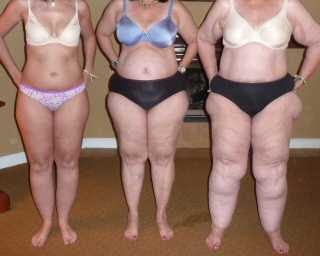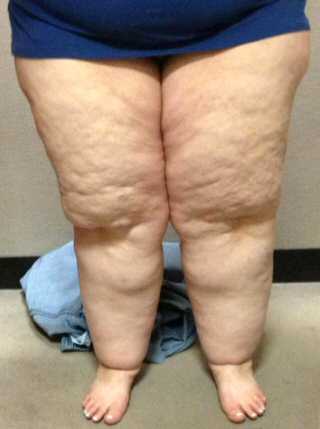The Haven
Healing Centre
The Orchard
Draycott Rd, Cheddar
Somerset

The Haven |

|
| Natural Complementary Therapies - your key to improved health and well-being | |
|
Home About Contact Gift Solutions Articles Treatments Products Page: 1 2 3 4 5 Appointments |
MLD Treatment for Lipoedema (Lipedema US)Treat your swollen legs & ankles using Manual Lymph DrainageLipoedema of the legs, thighs and buttocks. Great News! Manual Lymphatic Drainage Therapy helps!Lipoedema, known as lipedema in the USA, is a chronic disorder of adipose tissue generally affecting the legs, thighs and buttocks, which causes the legs and sometimes the arms to accumulate fatty tissue. The condition occurs almost exclusively in women, although there have been rare cases reported in men. Signs and symptoms of lipoedema The symptoms that concern me the most are many lipoedema patients feel strong pain in the underlying lipoedemic tissue.  They can be susceptibible to recurring blood infections, skin complaints and fibrosis.
They can be susceptibible to recurring blood infections, skin complaints and fibrosis.It's the fibrosis that is the most damaging. When you've had lipoedema for some time, even years, the subcutaneous tissue can harden and become fibrotic. Subcutaneous tissue contains fibrous bands which anchor the skin to the deep fascia. As the fatty tissue builds up, there is increasingly limited blood flow to the fibrous tissue which hardens and stimulates inflammation of the nearby tissue and the proliferation of connective tissue. A generalised inflammatory state can ensue, resulting in a restricted blood flow, which slows down healing and increases scaring. This can spread throughout the subcutaneous tissue of the thigh and leg. The symptoms then can become a little more serious, including itching, sensations that resemble restless leg syndrome, skin infections and blood disorders, all resulting in worry, irritation that needs a good scratch and pain. Anti-biotics can be used to control internal infection, but bacteria are very good at hiding inside fibrotic material, as the reduced blood supply means no anti-biotic is delivered to the area affected. What does may be such a minute dose that it is not enough to kill the bacteria that can now survive and build up an immunity. Subsequent courses of anti-biotic may not be effective and infections become more and more difficult to control. The degree of enlargement from the ankles up to the hips caused by lipoedema differs between individuals and it can gradually worsen over time. Symptoms of lipoedemia include disproportionately large, column-like legs, legs unusually large to the knees, disproportionate hips, stomach or buttocks. As lipoedema progresses, patients become increasingly heavy in the lower body. The additional, expanding fat cells interfere with the pathways of lymphatic vessels, and patients can develop secondary lymphedema, a condition known as lipo-lymphedema. Patients can become progressively less mobile as the condition increases. 
Unfortunately I can't give you a categoric 'yes' to that question. If caught early enough perhaps there is a possibility of a reasonable size change, but by the time a patient goes for help and finds a doctor that knows the signs to look for, instead of putting it all down to obesity and telling you to walk more or go on a diet, the condition is normally too developed for any meaningful reversal. Not enough research has been done into early diagnosis, but what I can promise you, because of the experiences of patients in the last 10 years or so, is some relief from your symptoms of lipoedema, AND, I may be able to give you some hope that if there is a lymphedema complication (a so called lipo-lymphedema), LDM will help with that too. The truth is, everybody's circumstances are different, and everyone responds in a different way. But, there is enough commonality in the relief of symptoms for you to have great hope that something will happen that you will be happy with. I'm aware that's not really an answer, but what I need for you to do is try it for a few weeks. My years of experience tell me, that once you feel the benefits, you will want to continue. If nothing else, because of the relief it gives from pain and irritation when stationary and walking. What causes lipoedema? Although the accumulation of fat tends to be worse in people who are obese, the condition is not caused by obesity and can affect people who are a normal weight. It should not be mistaken for obesity, as dieting often makes little difference to the condition. Frankly, the cause of lipoedema is not known. There may be a family history of the condition in some cases and it seems likely that the genes you inherit from your parents play a role. Lipoedema tends to start at puberty or at times of hormonal change, such as pregnancy or the menopause, and occurs almost exclusively in women. It is estimated that around 11% of women are affected. Lipedema can also be triggered by an extremely stressful situation such as a death in the family or a divorce because cortisol levels increase, causing an inflammation cascade, almost always misdiagnosed as simple weight gain. How can I tell the difference between lymphoedema and lipoedema? The skin of someone with lymphoedema will pit or indent when you press it, but this will not happen with lipoedema. How will what you do differ from what my doctor may offer me by way of treatment?  I will offer you Manual Lymphatic Drainage (MLD) which is a very soft and gentle treatment that works on the skin. If and/or when we see some improvement in the shape of the affected areas, we may include some massage techniques. You will need to come regularly because the impact of the treatment is cumulative and will take time to produce a result. However, when that result happens it is very powerful and a big lift to the patient.
I will offer you Manual Lymphatic Drainage (MLD) which is a very soft and gentle treatment that works on the skin. If and/or when we see some improvement in the shape of the affected areas, we may include some massage techniques. You will need to come regularly because the impact of the treatment is cumulative and will take time to produce a result. However, when that result happens it is very powerful and a big lift to the patient.Your treatment options in general practice are non-surgical treatments and liposuction. Non-surgical treatments can include painkillers, compression therapy (bandages or garments that squeeze the affected limbs), exercise (mainly low-impact exercises, such as swimming), and massage (to encourage the flow of fluid through your body). Tumescent Liposuction involves injecting a liquid solution into the legs to help numb the area and reduce blood loss, before the unwanted fat is sucked out through a tube. Liposuction does carry risks and if not done correctly there is a danger of unsatisfactory results, not the least of which is uneven contours. Several separate operations may be necessary to remove the fat from the different parts of your body. It's as well to point out here that currently there is no cure for lipoedema. BUT THERE IS SYMPTOM RELIEF through a variety of consistently applied techniques to improve the health of the legs and prevent the condition from returning at more difficult to manage levels. Treatments that don't work
Whatever you decide to do, please decide BEFORE it gets as bad as the pictures above. These pictures show extreme lipoedema, but remember, they are also normal. Manual Lymph Drainage in the treatment of lipoedema. MLD has a useful side effect. It can improve skin condition, colour, look and feel. It can soften the fibrotic tissue that otherwise harbours bacteria and causes infections. It can remove stagnant lymph from a limb and allow new, clean, nutritious, oxygenated fluid, and blood, to enter the cells and spaces between the cells and this can have a marked effect on overall health and well being. Visit The Haven Healing Centre in Cheddar for a course of MLD treatments. Appointments and a treatment price list are available by clicking here. I look forward to welcoming you soon. Phil. Please share this page with your friends. Thank you.
Note: DISCLAIMER: This information is not presented by a medical practitioner and is for educational and informational purposes only. The content is not intended to be a substitute for professional medical advice, diagnosis, or treatment. Always seek the advice of your physician or other qualified health provider with any questions you may have regarding a medical condition. Never disregard professional medical advice or delay in seeking it because of something you have read. It's a small investment in yourself, but could be a life-changing experience you will cherish forever. |
| Copyright © Philip Chave 2008- TheHavenHealingCentre.co.uk All rights reserved. Email: privacy |